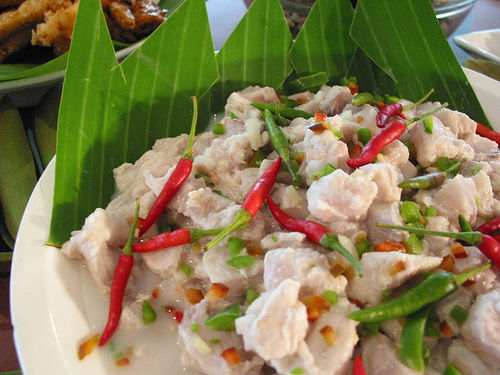Just I have thought that curry dishes (Indian food) is similar to the well-known Kapampangan dish "Kare-Kare". The looks maybe similar but the preparation is very different. So what is kare-kare anyway?
Kare-Kare is considered a stew dish which need the meat to boil for long hours in order to become tender. The typical meat that is use are the oxtail, offal/tripe and ox leg. This food is compose of peanut sauce with a variety of vegetables that are included after the meat have undergone the tenderization. It is common to serve with bagoong (shrimp paste) when eating
According to some food historians this dish has originated from the province of Pampanga, the culinary center of Philippines. But others said that it was that Moro's who has this because in Sulu and Tawi-Tawi this dish is popular to them, they even speculated that this food is being serve long before the arrival of Spaniards in Manila to the elite member just like the datus and rajahs.
Because of complication in preparing it, a typical Filipino can't afford to have this in their everyday's menu. In Pampanga where it originates, during fiesta this are common in every table. You can find this dish also among fine dining Filipino restaurant with a mild twist depending on the chef. Also Kare-kare can be bought in karinderia (side street pre-cook restaurant), but don't demand the authentic one because there might be an absence of one or two ingredients.
 |
| Kare kare a la Bistro Burgos |
INGREDIENTS:
Meat(beef):
- Ox tail
- Ox leg(optional but better if you have it)
- Ox tripe/offal
Vegetables:
- 2 pcs of eggplant - sliced it in slant
- 1 banana bud/heart/flower - sliced in diagonal
- 5 pieces of pechay
- 1 bundle of string beans
Other Ingredients :
- 2 cups of peanut butter
- 5 cloves of garlic - finely chopped
- 1 big onion - sliced thinly
- 2 tablespoons of cooking oil
How to cook:
- Wash the ox tail, legs and beef. Cut into serving pieces. Place in a heavy saucepan with enough water to cover. Bring to a boil, remove the scums as it rises, cover, add more water if you need to. Kare kare is better if the meat is tender. Let simmer until the meat is tender this will take about 1-2 hours.
- Transfer the meat into a plate or a bowl and let it cool, set aside the stock. (While others cooked the meat one day ahead, put it into the fridge to solidify the fat and remove it when cooking.)
- In a large caserrole put the cooking oil to saute the garlic and onion in about 30 seconds.
- Put the meat in the skillet and continue mixing.
- Pour in the stock and bring to a boil for another 10 minutes.
- Add the vegetables.
- In a small bowl, stir the peanut butter with about 1/2 cup of stock and pour it in the caserrole. Stir to blend well. Cook for another 5-10 minutes until the sauce is thick.
- Serve hot with bagoong alamang and boil rice.
Photos from pehpot.com and faithraagas.blogspot.com









 5:56 AM
5:56 AM
 Unknown
Unknown

















